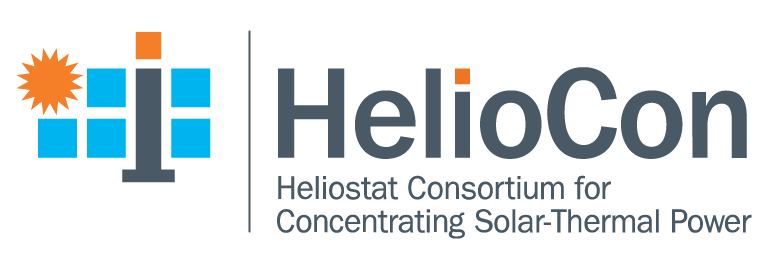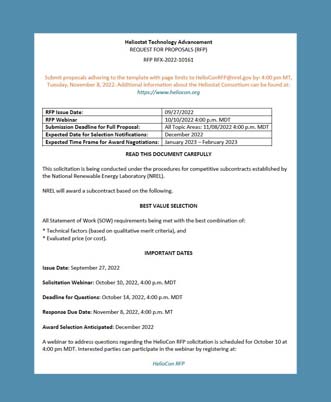HelioCon Request for Proposals
2024 Round 2 Summaries
The U.S. Department of Energy’s (DOE’s) Heliostat Consortium awarded $3 Million for six projects from the second request for proposal (RFP) to advance heliostat technology and workforce for commercial readiness. The six awardees are:
The U.S. Department of Energy’s (DOE’s) Heliostat Consortium awarded $3 Million for six projects from the second request for proposal (RFP) to advance heliostat technology and workforce for commercial readiness. The six awardees are:
- DKA Design LLC, in partnership with Heliogen, will develop a centralized, low-labor method to estimate the cleaning increase in mirror specular reflectance. By analyzing the different intensities of reflected light from shaded and unshaded regions of each selected and deliberately tilted (“off sun”) heliostat mirror, the amount of soiling thereof will be determined utilizing imaging data from existing and centralized heliostat control system sensors.
- Rice University, This project will work to uncover and address the root cause of gaps in educational training opportunities in concentrating solar (CS) systems, with an emphasis on community integration. While there are scattered individual classes offered on the undergraduate and graduate level in 4-year institutions that touch on CS topics, many of these courses include only a brief CS overview or emphasize photovoltaics (PV) over CS in solar-focused units or courses.
- Northeastern University, The goal is to advance education on Heliostats via targeted classroom instruction and conduction of undergraduate-level research and development projects. It is also planned to institutionalize heliostat education by incorporation in course syllabi examples and homework assignments related to concentrated solar energy. Such courses include Freshman Cornerstone of Engineering I and II, Controls, Robotics, Mechanical Design and Engineering, as well as Financial Management for Engineers. This proposed program will be developed during a two-year period. Afterwards, it will become part of the Northeastern University Engineering Curriculum
- University of WI, Madison, The PROMETHEUS project aims at developing an innovative tool to improve real-time heliostatcontrol and aiming in the solar field. The tool will optimize the aiming strategies accounting for flux intensity impact on receiver lifetime, the actual status of the heliostats (soiling distribution, broken mirrors and/or drivers), and required driver power consumption during transient operation. Nowcasting of the solar radiation and its spatial distribution in the short term (5 to 15 minutes) is incorporated into the solution approach
- University of Nevada, Las Vegas, This project aims to address the objectives outlined by HelioCon, with a primary focus on improving the economic performance of heliostat fields through the development of a cutting-edge measurement instrument called the Operating Surface Angle Measurement System (OSAMS). Itis designed to enhance the accuracy and efficiency of heliostat design, prototyping, and field performance evaluation by enabling precise measurement of various parameters affecting heliostat accuracy of the reflective beam.
- Mark Ayres Engineering, The current state of the practice for the heliostats solar field control system within the CSP community is characterized by a lack of standardization and reuse among the various parties involved in the development of those central receiver solar power plants. The proposed project is aimed at solving this issue by developing an advanced Heliostat Field Control System (HFCS) that consists of multiple modules for the various required functions and can be easily adapted to different heliostats/solar field configurations to reduce the costs and enhance the solar field performance over today’s technology.
Click here to view the RFP 2 webinar recording.
Passcode: @@I24Esp
2023 Round 1 Summaries
In June of 2023, the U.S. Department of Energy’s (DOE’s) National Renewable Energy Laboratory (NREL) and Sandia National Laboratories, co-leads of the Heliostat Consortium, announced seven awardees from a request for proposals (RFP) aimed at achieving DOE’s goals for heliostat cost reduction, sustained multifaceted innovation, and improved solar field performance. The seven awardees are:
- SunRing: Advanced Manufacturing and Field Deployment: This project by Solar Dynamics LLC and partners will develop processes to maximize cost-competitiveness, performance, and reliability of Solar Dynamics’ existing SunRing heliostat design. The project will implement off-site preassembly and kitting for the heliostat subassemblies, conceptually develop and prototype an automated manufacturing cell that is transportable and redeployable for future projects, develop a comprehensive installation and commissioning schedule, and compile a holistic cost model of the SunRing to develop a business case and aid in site and design decision-making.
- HELIOCOMM: A Resilient Wireless Heliostats Communication System: This components-and-controls project by the University of New Mexico will model a resilient wireless communication system based on the principles of integrated access and backhaul (IAB) technology, entropy-based routing, dynamic spectrum management, and interference mitigation. These technical advances will enable an industry pathway to low-cost, wirelessly controlled heliostat fields through photovoltaic-powered controls and communications with reduced energy usage, as well as safety and resilience through faster (milliseconds) communication and reduced risk of communication breakdowns or losses.
- An Educational Program on Concentrating Solar Power and Heliostats for Power Generation and Industrial Process: This project by Northeastern University will develop an educational program focused on concentrating solar power (CSP) and heliostats for power generation and industrial processes. It will be developed during the two-year project and then become part of the Northeastern curriculum for undergraduate and graduate engineering students.
- Demonstration of a Heliostat Solar Field Wireless Control System: Solar Dynamics LLC, with partners Remcom and Vanteon Corporation, will carry out a project aimed at demonstrating the reliable operation of a wireless heliostat solar field control system using commercially available products and developing analytical tools to de-risk the large-scale deployment of the wireless technology to solar fields with tens of thousands of heliostats. In parallel, a wireless radio frequency computer simulation of the demonstration system will be developed. The overall project goal is to prove that the wireless technology is fully capable of replacing traditional wired networks with minimal compromises.
- Twisting Heliostats With Closed-Loop Tracking: This project will design, manufacture, and test a new type of heliostat and study its application for high-concentration CSP. The University of Arizona will integrate a DOE Small Innovative Projects in Solar (SIPS)-type reflector with a high-accuracy mount and tracking camera to demonstrate an accurately focused and centered image of the solar disc. This will be maintained automatically throughout the day by mechanically coupled twisting of the reflector. Even when using perfectly focused facets, distortions of the reflected image on the receiver are introduced due to the non-normal incidence between the heliostat and the receiver. The dynamic focusing of the mirror facet can result in a reflected image that approaches the theoretical limit, potentially leading to higher operating temperatures for concentrated solar power (CSP) and industrial process heat applications.
- Digital Twin and Industry 4.0 in Support of Heliostat Technology Advancement: The Tietronix project aims to leverage technologies from the Fourth Industrial Revolution (Industry 4.0) to enhance the CSP industry and achieve the cost reduction experienced by other industries that have already adopted such advancements. This project will use a model-based systems engineering approach to improve the design, analysis, and verification of heliostats and overall solar fields. The project will also use digital twin technology during the heliostat manufacturing process, conducting thorough testing before achieving full functionality. This approach ensures quality and enables optimization of solar field operations by providing comprehensive insights into heliostat performance. The project will demonstrate the potential of machine learning algorithms, virtual-reality training, and augmented-reality techniques in reducing operational costs and enhancing overall performance.
- Robotic-Assisted Facet Installation (RA-FI): Sarcos Technology and Robotics Corp., in collaboration with Heliogen, will investigate the feasibility of a novel mobile robotic system capable of supporting the installation of mirror facets onto a heliostat. The primary goal of this proposed effort is to refine the understanding of the challenges related to mirror facet installation to analytically determine the feasibility to address this task robotically from the vantage point of both technical and business considerations.
Recorded HelioCon RFP Webinar
Passcode: =$f55jR@

